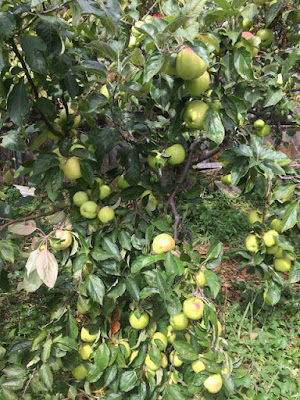Lian is a keen food gardener who has been a Food Garden Group member for quite a few years. Lian took part in the 2020 In My Garden series, and contributed to the FGG blog post on deep hay mulching.
Lian lives in Lauderdale, and that means that in many a past summer her garden was sunnier and warmer than most other food gardens. In this In My Garden Lian shares how her food garden has done in the challenging 2021-2022 summer.
Herbs – I have always had dreadful trouble keeping plants alive in pots; they invariably dry out. This year I realised (at last!) that I need to water them every day in summer. Consequently, I have a good herb collection this year, and have discovered that the addition of mint does amazing things for spinach pie.
Apples – my big old apple tree has had an amazing crop this year. I've never yet been able to work out what sort of apples they are, but they come on very early, and are tart and crisp. They also have a five-star rating in the Musk Lorikeet Guide to Tasmania, so it's a bit of a competition to see who gets more of them, the lorikeets or me. I’ve been stewing and bottling and making apple cider vinegar, so the few that are left are for the lorikeets.

My small apple tree is Granny Smith with Jonagold grafted onto it, and I net it carefully every year – so far the lorikeets haven’t noticed it. The Granny Smiths and the Jonagolds seem to take it in turns to have a good year. This year it’s the Jonagold’s turn.
I used to grow Marina di chioggia pumpkins, but haven't been able to get any seeds for the last three years, so now I grow Queensland blue in bins, with varied success. This year they’ve been reasonable rather than brilliant.
The only reasonable way I have found to keep cabbage whites off my brassicas is with netting. This does the trick beautifully, though I find an occasional Houdini moth has somehow squeezed through the holes.
The photo below shows a sultana grape, very prolific and very sweet when ripe. But I don't think I'm going to get much of a crop this year. Too much mildew around.
Lots of self sown rocket and milk thistle are coming up in the ends of my asparagus bed. I use milk thistle, chickweed and dandelion leaves in bitter-leaf salads or stirfries whenever I can find them. They are particularly useful over winter when there’s not a lot of variety in greens. Good for pesto in winter, too.
My little fig tree is doing well this year – best crop yet. I didn't have many in its first cropping before Christmas; only about three figs. But there are a lot growing now.
A good year for sweetcorn, too! I don't like the new super sweet varieties, so for the last couple of years I have tried to grow True Gold, a heritage variety from Southern Harvest. I've had dreadful trouble getting them to germinate, with a massive failure rate. This year I tried to germinate them in trays, thinking that might be easier, but they still failed. So I turned to Kelvedon Glory F1, which was described as 'golden cobs with traditional flavour'. They germinated pretty much immediately, and have been very successful. Their taste isn’t quite traditional, but it’s not bad.
My parsnips put on so much greenery this year that they quite overwhelmed the carrots and onions that were in the same bed.
I usually sow my first crop of parsnips and carrots in late October, to get in ahead of the insects that play havoc with the seedlings. But they end up pretty woody and far too big, whereas the ones I sow at the end of November are much better. So I think I might scrap that first crop next season.
Like most people, I have had very late tomatoes this year. But now they are ripening quickly. Last year I grew them in wire cages, as an experiment. It was not a success. Because the cage contained them so well, I didn't cut out nearly as many laterals, and the foliage became quite crowded. Combine that with last summer's humidity and I ended up with some really nasty black mildew that I’d never seen before and never want to see again. So this year I went back to tying them to stakes.
The earliest ripening were Ross's Lady Elizabeth. Most disappointing were Daydream and Moneymaker. Cherokee Purple and Black Cherry are their usual reliable, tasty selves. Gross Lisse, Mama Mia, Tommy Toe are all producing well, and worth another go next year.
Fantastic, Lian, that was a great virtual tour. I feel that we are up to date now. Thank you for sharing all this, and may the season continue to be successful for you!














No comments:
Post a Comment
Note: Only a member of this blog may post a comment.